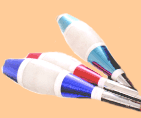Windows Trix -- some so old but still work like new
Screen
Copies
· Prt-scr – copy screen to clipboard
· Alt-prt-scr – copy window to clipboard
· Speed up scrolling by Pressing and holding
the Ctrl key while you scroll.
· To expand all the subfolders of a selected
drive in Windows Explorer, press the asterisk (*) key on the numeric
keypad (this could take a while if the directory has lots of folders
in it). But watch out-there's no easy way to collapse them again.
· To restore the default column widths in
the Details view of any folder window and many program or applet windows,
press Ctrl and the plus sign (+) key on the numeric
keypad.
· Win9x has trouble retaining default folder and
Explorer window settings-such as size, position, sort order, toolbar
status and display type (large icons, details and so on). Here's a
temporary workaround. Open the folder for your C:drive, and without
opening any other folders, arrange and configure it exactly as you'd
like all your folders to appear. When you're ready to set the default,
press Ctrl+Alt+Shift while you click the close box
in the upper right-hand corner of the window. There's a limit to the
number of specific folder instances Win9x can remember, so eventually
your setting may roll off the list. Repeat the steps to restore your
settings
· Find out exactly what a program does when you install it
by using the System File Checker's log feature. After installing program,
open the log by launching the System Information utility (Start/Programs/Accessories/System
Tools/System Information), choosing System File Checker from the Tools
menu, clicking on the Settings button and then on the View Log button.
The log will tell you exactly which files were added to your computer
and which were updated with a newer version.
· Take any .BMP file, rename it to give it an .ICO
extension, and voila! Instant icon. You access the file in the normal
way: Right-click on the current icon for a shortcut, select Properties
from the Context menu, select the Shortcut tab and click on the Change
Icon button. Now use the Browse button to find your new one. I use
the paint program to do this to create favicons for Web sites.
· Win98 comes with a handy way to check your Registry for errors.
Launch the Microsoft System Information (MSI) utility from Start/Accessories/System
Tools/System Information, then select the Registry Checker from the
Tools menu.
· Insert the current time and date in Notepad by pressing
F5. Or, if you want to log the date and time automatically
each time you open a Notepad file, type .LOG on the first line, then
save and close the file. Every time you open the file thereafter,
the current date and time will be recorded in it.
· To manage the active window, press [Alt][Spacebar].
Then press the appropriate hot key to select Restore, Move, Size,
Minimize, Maximize, or Close.
· Get with detailed columns - Windows Explorer
gives a customizable view of the files and folders on your computer
or network. By default, when you highlight a folder in the left pane,
you view the files and subfolders in the right pane. But these views
can be customized by Detail, List, Large Icons, or Small Icons views
using the Views menu.
· RESCUE YOUR WINDOWS PRODUCT KEY If you ever have to reinstall
Windows 9x from a CD, one of the worst problems you can face is to
find that you no longer have the original CD case and its Product
Key. Without the Product Key, you may find that you cannot reinstall
Windows. However, because you were asked for the Key when you first
installed Windows, it's saved in the registry. This means that you
can locate it before removing Windows from your system. Even if you
are unable to start Windows, as long as you can get to the command
line, you can run this on the System.dat file that's part of the registry.
At a command prompt, type one of the following commands (depending
on which version of Windows you are working with):
· For Windows 95 installations, type:
FIND.EXE/I
"ProductId" %winbootdir%\SYSTEM.DAT
The
%winbootdir% should look up the folder in which Windows is
installed; however, it can only do this if the system environment
variable is set.
If you've had to boot the computer from a floppy, then it might not
be
set. In that case, you should "cd" into the folder where
System.dat is
located and run the command from there.
For
Windows 98 installations, type:
FIND.EXE/I
"ProductKey" %winbootdir%\SYSTEM.DAT
The
first line of the values returned should show the product key in a
form similar to ?????-?????-?????-?????-?????.
If
you select the Details view, you get Name, Size, Type, and Modified
columns with details on each file and folder. Each column is resizable
for information viewing preferences. It's also possible to (on purpose
or by accident) drag each of the column width markers to the left
edge of the pane--effectively making them disappear.
Once
created, there is a way out of this blind view. Click in the empty
right-hand pane and simultaneously press [Ctrl] and the plus sign
(+)from the keyboard's
numeric keypad. This sets the column widths back to the default minimum
width.
In
addition, you can fix the problem over a Win 9x client network if
you have remote access to users registries. Locate the
HKEY_CURRENT_USER\Software\Microsoft\Windows\CurrentVersion\Explorer
key,
and delete the DirectoryColsX subkey. This will automatically
· reset the column widths on the next startup of Explorer.
DOS
tricks
Pkzip –ex -& zipfile sourcefiles
Xcopy/s/c source [destination]
Doskey/ insert --- command line editing utility like bash but more
limited



